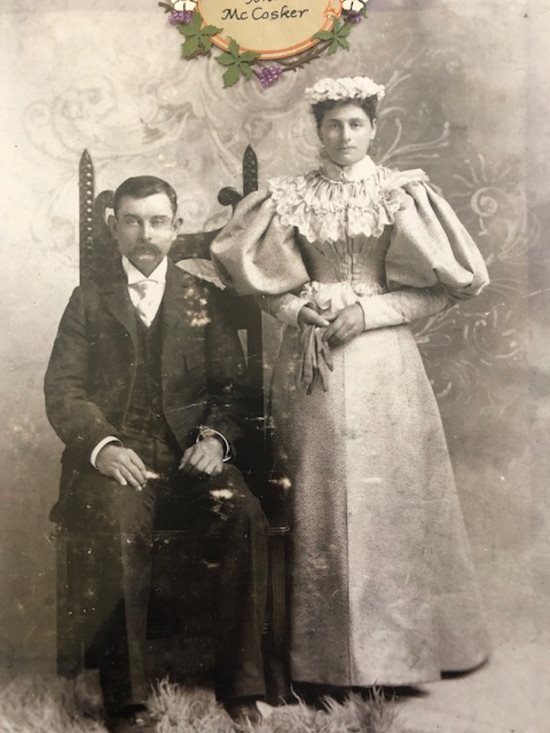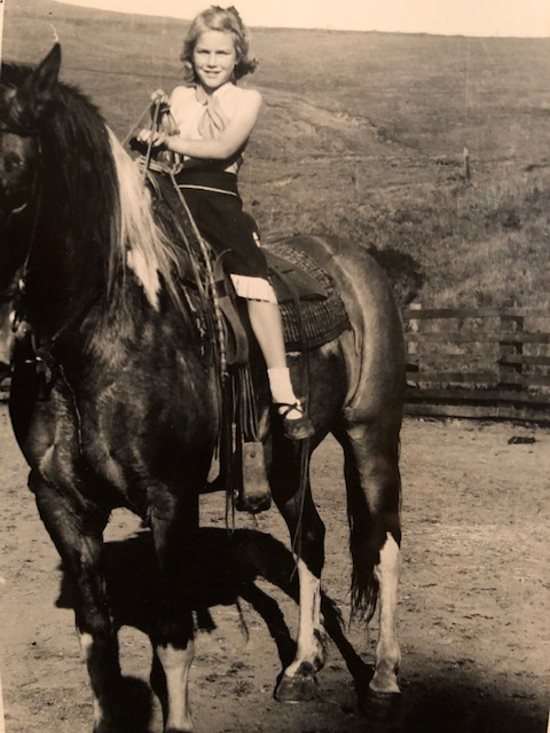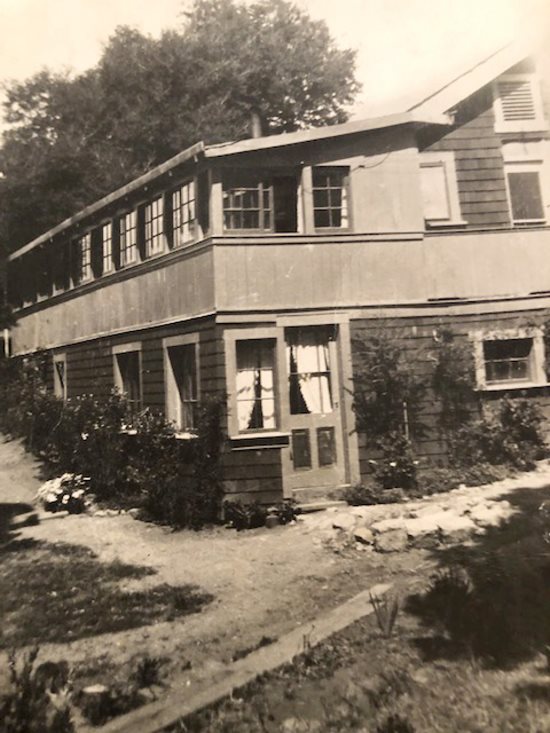|
|
Published March 18th, 2020
|
Canyon's historical roots run deep
|
|
| By Vera Kochan |
 |
| Saputo's grandparents, John and Mary McCosker (Pereira), married 1896 Photo provided |
The Moraga Historical Society hosted a presentation titled "Canyon, a Unique Community" with guest speaker and longtime Canyon resident Vicki McCosker Saputo. The Feb. 27 event, at the Moraga Library, drew an unexpectedly large crowd eager to hear about days-gone-by involving our neighbors who dwell among the redwood trees.
 Saputo can be considered a historian of the area in that her ancestors have inhabited the region since the 1850s. Her McCosker side of the family, going as far back on the family tree as her great-grandparents, have lived in Canyon for nearly 160 years. Her maternal great-grandparents (Pereira) settled there from Portugal in the 1850s. Later generations continued the tradition through four grandparents, 13 great aunts and uncles, her father and his five siblings.
Saputo can be considered a historian of the area in that her ancestors have inhabited the region since the 1850s. Her McCosker side of the family, going as far back on the family tree as her great-grandparents, have lived in Canyon for nearly 160 years. Her maternal great-grandparents (Pereira) settled there from Portugal in the 1850s. Later generations continued the tradition through four grandparents, 13 great aunts and uncles, her father and his five siblings.
 "Canyon is in my blood," stated Saputo. "I lived there for 10 and a half years in my early 20s and 30s. My sons were born there and my eldest, Sean, lived there a total of 20 years, because he lived there again in his 20s with my granddaughter, Seaya, who's mother, Maya, also grew up in Canyon." Her granddaughter is the sixth generation to call Canyon home.
"Canyon is in my blood," stated Saputo. "I lived there for 10 and a half years in my early 20s and 30s. My sons were born there and my eldest, Sean, lived there a total of 20 years, because he lived there again in his 20s with my granddaughter, Seaya, who's mother, Maya, also grew up in Canyon." Her granddaughter is the sixth generation to call Canyon home.
 Through recollection and research, Saputo has put together a timeline of events, to the best of her knowledge, that occurred in Canyon during the days when her family first came to the region.
Through recollection and research, Saputo has put together a timeline of events, to the best of her knowledge, that occurred in Canyon during the days when her family first came to the region.
 Attention was first drawn to the canyon in 1845 when ships coming into San Francisco noticed the 300-foot tall redwood trees through the "golden gate." Many of the trees had a diameter of 30 feet, much like sequoias, which is why Canyon was initially called Sequoya. Living among the trees were wild animals such as condors, bears, mountain lions and bobcats.
Attention was first drawn to the canyon in 1845 when ships coming into San Francisco noticed the 300-foot tall redwood trees through the "golden gate." Many of the trees had a diameter of 30 feet, much like sequoias, which is why Canyon was initially called Sequoya. Living among the trees were wild animals such as condors, bears, mountain lions and bobcats.
 "The so called `Gold Rush' of lumber scattered the wildlife when 300-400 lumbermen descended and four saw mills were set up (first with whipsaws and then steam saws)," Saputo said. The lumber camps prospered between the 1850s and 1860s with much of the lumber being used to help build San Francisco's luxurious hotels and buildings as well as the San Jose Mission and buildings in the general Bay Area.
"The so called `Gold Rush' of lumber scattered the wildlife when 300-400 lumbermen descended and four saw mills were set up (first with whipsaws and then steam saws)," Saputo said. The lumber camps prospered between the 1850s and 1860s with much of the lumber being used to help build San Francisco's luxurious hotels and buildings as well as the San Jose Mission and buildings in the general Bay Area.
 Re-christened Redwood Canyon, it became the economic center of the East Bay at which point it was the first stage coach stop between Oakland and Walnut Creek. The community had two hotels, a liquor store, post office, a gambling den and a grocery store. Once the lumber trade died down, thanks to over-production, Canyon's economy turned to hunting, trapping and farming.
Re-christened Redwood Canyon, it became the economic center of the East Bay at which point it was the first stage coach stop between Oakland and Walnut Creek. The community had two hotels, a liquor store, post office, a gambling den and a grocery store. Once the lumber trade died down, thanks to over-production, Canyon's economy turned to hunting, trapping and farming.
 In 1865, Saputo's paternal great-grandparents, Patrick and Cathrin McCosker, arrived in Canyon via Ireland, Philadelphia and San Francisco. Building a house and later a barn (with the help of hired Native Americans) they became the first homesteaders, locating at the end of Pinehurst Road. The McCoskers and Pereira families were neighbors and eventually became friends, between them owning over 450 acres of Canyon land used for cattle grazing, and growing clover and alfalfa.
In 1865, Saputo's paternal great-grandparents, Patrick and Cathrin McCosker, arrived in Canyon via Ireland, Philadelphia and San Francisco. Building a house and later a barn (with the help of hired Native Americans) they became the first homesteaders, locating at the end of Pinehurst Road. The McCoskers and Pereira families were neighbors and eventually became friends, between them owning over 450 acres of Canyon land used for cattle grazing, and growing clover and alfalfa.
 According to family lore, in 1855, famed Mexican bandit Joaquin Murietta once stole $100 from great-grandfather Joseph Pereira who was on his way to a cattle auction at Valle Vista (now under the San Leandro Reservoir). Days later, Murrieta stopped by the ranch to leave Pereira a whopping $400 in return.
According to family lore, in 1855, famed Mexican bandit Joaquin Murietta once stole $100 from great-grandfather Joseph Pereira who was on his way to a cattle auction at Valle Vista (now under the San Leandro Reservoir). Days later, Murrieta stopped by the ranch to leave Pereira a whopping $400 in return.
 In the early 1900s a train ran through Canyon and eventually along St. Mary's Road to Lafayette. Originally called the Oakland/Antioch/Eastern Railroad before it was renamed the Sacramento Northern Railway, which extended up to Chico. Once the Broadway Tunnel (now known as Caldecott) was built in 1937, the passenger trains ceased to run.
In the early 1900s a train ran through Canyon and eventually along St. Mary's Road to Lafayette. Originally called the Oakland/Antioch/Eastern Railroad before it was renamed the Sacramento Northern Railway, which extended up to Chico. Once the Broadway Tunnel (now known as Caldecott) was built in 1937, the passenger trains ceased to run.
 A one-room Canyon School was built in 1918. The current school was built in 1986.
A one-room Canyon School was built in 1918. The current school was built in 1986.
 The 1960s saw the Hippie culture descend on Canyon. Drugs, sex and untidy surroundings forced many longtime Canyon residents to move to family-friendly neighborhoods.
The 1960s saw the Hippie culture descend on Canyon. Drugs, sex and untidy surroundings forced many longtime Canyon residents to move to family-friendly neighborhoods.
 In 1969, the Canyon Store and several other buildings were destroyed when a Shell Oil pipeline running from Martinez to Oakland International Airport was intentionally blown up during a labor strike. Shell offered a $50,000 reward, but no one was ever convicted of the disaster that set Canyon on fire, injuring several citizens and killing one employee.
In 1969, the Canyon Store and several other buildings were destroyed when a Shell Oil pipeline running from Martinez to Oakland International Airport was intentionally blown up during a labor strike. Shell offered a $50,000 reward, but no one was ever convicted of the disaster that set Canyon on fire, injuring several citizens and killing one employee.
 John H. McCosker, Saputo's father, used the helicopter pad and lake on his property to help during the Oakland Hills fire of 1991. She also recalled, "Dad planted 150 redwoods on his property." That was 26 years ago, and she now guesses the trees to be around 80 feet tall.
John H. McCosker, Saputo's father, used the helicopter pad and lake on his property to help during the Oakland Hills fire of 1991. She also recalled, "Dad planted 150 redwoods on his property." That was 26 years ago, and she now guesses the trees to be around 80 feet tall.
 Saputo rode horses as a child throughout the Canyon area, and it continues to be a favorite activity for her. The various types of terrain and views from different vantage points still draw her in. "I've traveled all over the world and ridden in many lands, but Canyon continues to be my favorite. It's like a live meditation for me."
Saputo rode horses as a child throughout the Canyon area, and it continues to be a favorite activity for her. The various types of terrain and views from different vantage points still draw her in. "I've traveled all over the world and ridden in many lands, but Canyon continues to be my favorite. It's like a live meditation for me."
 Describing the approximately 215-member Canyon enclave of today, Saputo stated, "There are a variety of people and houses in this community ranging from mansions and other nice homes and log cabins, to straw roofs and domes, tree houses and trailers, apartments, big and little homes."
Describing the approximately 215-member Canyon enclave of today, Saputo stated, "There are a variety of people and houses in this community ranging from mansions and other nice homes and log cabins, to straw roofs and domes, tree houses and trailers, apartments, big and little homes."
 Maybe, if conditions are just right, one can still hear the saw mills grinding, the cattle mooing, the gamblers playing cards or the ghosts of Canyon's past continuing to live on in the small community among the mighty redwoods.
Maybe, if conditions are just right, one can still hear the saw mills grinding, the cattle mooing, the gamblers playing cards or the ghosts of Canyon's past continuing to live on in the small community among the mighty redwoods. |
 |
| Saputo riding Suncloud at the family ranch c.1953 Photo provided |
 |
| McCosker family's Old Home Ranch Photo provided |
|
|
|
|
|
|
|
|
|





